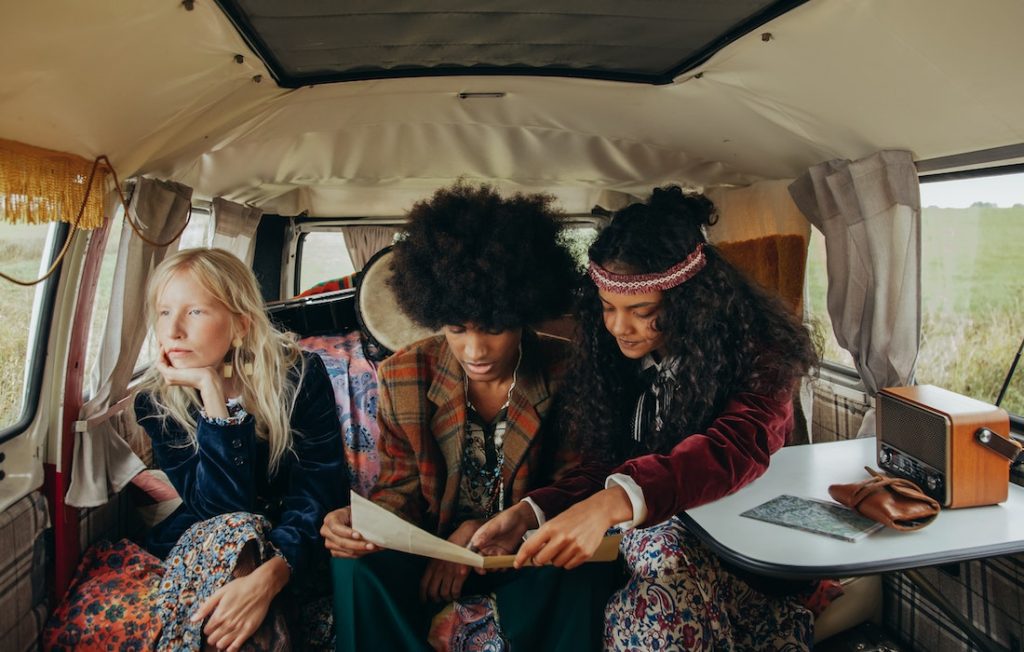- The 1970s hippie movement was a counter-cultural revolution focused on peace, love, and harmony.
- Hippies embraced a back-to-nature lifestyle by living off the land, embracing vegetarian/vegan diets, natural remedies, and alternative medicine.
- Relationship and sexual norms were open and free love was promoted.
- Fashion symbolizes identity and influences trends today, such as the Grateful Dead collection.
- Beliefs revolved around environmentalism, individual autonomy, and finding joy in simple things.
The 1970s was an era of a cultural revolution that saw the rise of the counterculture movement. Often referred to as the hippie movement, this generation broke free from societal norms, embracing peace, love, and harmony.
One of the most popular activities among hippies was the Hippie Trail. It was an overland journey from Europe to India, and it became notorious for attracting young people to the hippie way of life. The Hippie Trail became synonymous with a particular lifestyle, fashion, and belief system. Today we will deep dive into the world of the 1970s hippie trail.
Lifestyle
The hippie counterculture movement of the 1960s continued to thrive and evolve in the 1970s, bringing with it a radical shift in lifestyle beliefs and practices. From music, fashion, and lifestyle choices, the hippies took a stand against capitalism, materialism, environmental degradation, and war.
A Back-to-Nature Lifestyle
The 1970s hippie movement emphasized living off the land and being in tune with nature. Many hippies moved to rural areas to start communes where they could grow food, raise livestock, and live self-sufficiently.
They embraced a vegetarian or vegan diet, natural remedies, and alternative medicine. They believed in the sacredness of mother earth and treated it with respect, leading the environmental movement that gained momentum in the 1970s.
Relationship and Sexual Norms
Hippies had an open view of relationships and sexual norms; they opposed the traditional conservative values of the time. They believed that love should be free and expressed it openly, often in public.
Free love, a buzzword of the 1970s, promoted non-monogamous relationships. The hippie culture played a significant role in accepting homosexuality as usual. They believed in gender equality, and it was common to see hippie men and women in androgynous clothing.
Fashion

The 1970s was a decade of social, cultural, and fashion revolution in the United States, and the hippie movement played a significant role. With their long-haired and bell-bottom jeans characteristic, hippies put forward a countercultural image of freedom, peace, and love.
The era’s fashion was a symbol of identity, and it has continued to influence fashion trends till today. One brand that recently captured that 70s hippie fashion is the Grateful Dead licensed clothing collection. The collection perfectly blends nostalgic and contemporary fashion, reliving the era while still appealing to current fashion sensibilities. It is undoubtedly an excellent choice for anyone looking to fuse the retro with the modern.
Beliefs
A subculture of young people seeking a more positive and sustainable way of life, the hippies’ beliefs and practices were steeped in peace, love, and cultural rebellion. Here are the ethos and ideas of 1970s hippies, exploring what motivated them, what they believed in, and how their movement still resonates today.
The Idea of Environmentalism
One key tenet of the hippie movement was the idea of environmentalism and a deep love and respect for the earth. Hippies were committed to living sustainably and in harmony with nature, often residing in communes where they could grow food and live as close to the land as possible.
Individuality and Personal Autonomy

One of the defining features of the hippie movement was its emphasis on individuality and personal autonomy. Hippies sought to break free from the conservative values and expectations of their parent’s generation, embracing unconventional ways of living and expressing themselves.
This often took the form of clothing styles that were bold and colorful, as well as experimenting with music, art, and poetry as a way of expressing their unique worldviews.
The Hippie Trail
The Hippie Trail was a journey that started in Europe and ended in India. It was around 6,500 miles and took about six months to complete. The trail passed through countries such as Iran, Turkey, Afghanistan, Pakistan, and India. It allowed young people to immerse themselves in different cultures and experiences. The trail was notorious for drug use and sexual experimentation, becoming a dangerous journey.
The Takeaways
The 1970s hippie trail is a fascinating part of our history that still influences our culture today. The lifestyle, fashion, and belief system established on the trail inspire us to live in harmony, reject materialism, and find joy in simple things. While the 1970s hippie trail has come and gone, it has left a permanent mark on our society.
It’s a reminder of the power of non-conformity in creating change and inspiring others to live on their terms. As we look back on the 1970s hippie trail, we can learn a lot about living a fulfilling life that is true to ourselves.





